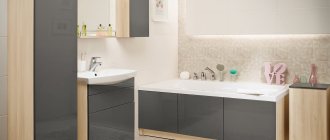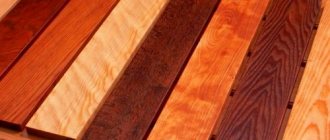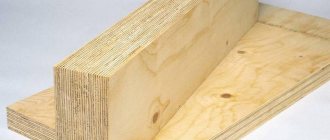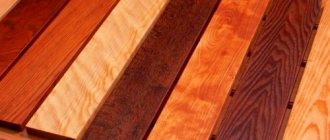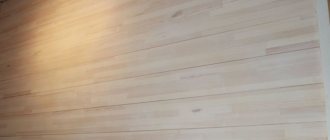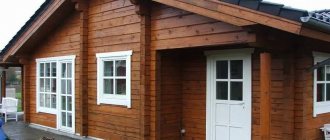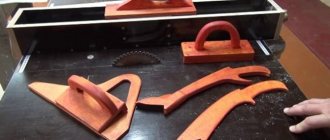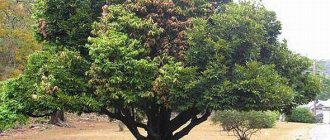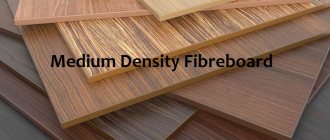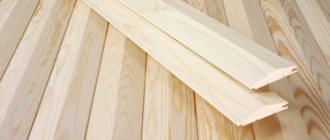In the production of furniture and some finishing materials, innovative particle boards are used. Outwardly, they are similar to laminated chipboard, but they have their differences in terms of safety and durability. Before purchasing, you should study everything about MDF: what it is, the advantages of the material and where it is used.
MDF sheet panels Source images.fordaq.com
General information about MDF
MDF is a material that has a wood structure.
MDF is a medium density pressed sheet with a wood fiber structure. They were first heard of in the United States of America in 1966. In Sweden, the technology was improved. Innovative developments in building materials came to Russia only in 1997. The first plant was opened in the village of Sheksna, Vologda Region. The board did not immediately gain popularity, but thanks to its advantages, it gradually began to replace the previously common chipboard.
Main features
The uniqueness of the pressed canvas is its similarity to natural wood and ease of manufacture. Panels are created from shavings, just like chipboard, but unlike the latter, the mass is highly crushed and heated.
As a result of this innovation, natural glue is released from the wood, which makes the material safe for health. A special production method gives the product strength, it does not crumble when drilled, and lends itself to any carpentry interventions (complex carving, sawing).
Decoding the abbreviation
MDF is the Russian equivalent of the American abbreviation. In English the name sounds like medium density fiberboard. Literally translated, it means medium-density fiber board.
MDF is a medium density fiberboard.
Properties
Thanks to innovative production technology, the fine particle board differs in its characteristics from its closest competitors: chipboard and fiberboard. Basic indicators:
- strength – withstands loads without traces of deformation, similar to wooden structures;
- moisture resistance – permissible operating conditions at air humidity up to 80%;
- biostability – not susceptible to mold, bacteria, fungi;
- environmental friendliness - non-toxic additives are used in production, the product is marked E1, safe for use in residential premises;
- uniformity - without defects;
- heat resistance – does not deform under the influence of temperature changes;
- insulating properties - does not allow sounds to pass through;
- manufacturability - lends itself to any tools, is easy to glue, paint or varnish.
Advantages
High performance characteristics give MDF sheets valuable properties:
- safe in the children's room, kitchen and bathroom;
- suitable for creating complex structures of non-standard shape;
- used on curved surfaces;
- do not require preliminary leveling before painting and decorating;
- suitable for floors, ceilings, walls;
- hold fittings and fasteners well;
- do not require special skills during installation;
- Easily interchangeable if damaged.
MDF sheets are safe in a child's room.
Among the advantages of pressed fiber boards are a low price compared to natural wood, a long service life and a large selection of decorative options.
Flaws
- Highly flammable. MDF ignites quickly when in contact with an open flame. In addition, the material may ignite upon prolonged contact with hot objects. Even faulty wiring next to MDF furniture can cause an ignition.
- Low resistance to mechanical damage. Despite the high density of the material, particle boards can be damaged if a heavy object falls or is hit.
- The need for additional drilling of holes for fasteners. Due to the hardness of the material, it is impossible to drive a nail or screw a screw into it; you must first drill the necessary holes for subsequent connection of the parts.
- Dust. During processing of MDF, a huge amount of fine dust is generated, so it becomes necessary to use a respirator to prevent small particles from entering the respiratory tract.
- Price. Particle boards are highly expensive compared to other materials - chipboard, fiberboard. To a greater extent, this is due to the fact that the production of this material has not been established in our country.
Specifications
Physico-mechanical properties of wood fiber fabric:
- The density of the finished product is in the range of 600-980 kg/m3.
- Withstands mechanical stress during bending of 17-23 MPa, during tension - 0.50-0.65 MPa.
- Within 24 hours, it withstands swelling by 17% at a sheet thickness of 6-9 mm, and no more than 8% at 30-45 mm.
- The elastic modulus is 1700 mPa.
Compound
The main component of MDF is wood fibers, the content of which is 82%. Urea-formaldehyde resins act as a binder - 9%. Water accounts for 8% and 1% is paraffin, which gives water-repellent properties to the finished product.
Wood fibers are the main component of MDF.
Dimensions
In construction and furniture production, slabs of various sizes are used:
- thickness, mm – 3, 4, 6, 10, 16, 18, 24, 30;
- length and width – 2070x2800 mm, 1830x2440 mm, 2070x2620 mm.
At the same time, moisture-resistant panels have a standard size of 1220x2400 mm, and laminated sheets, embossed, perforated and imitating stone - 2070x2800 mm.
Permissible deviation in width and length is ± 5 mm, in thickness ± 0.2 mm. The deviation from the straightness of the edges should not be more than 0.2 cm.
Shades of different colors and textures
A great advantage is the wide choice of shade and texture of panel patterns. In most cases, the pattern imitates different types of wood.
MDF wall panels are made using the same technology, but the surface of such products may have different finishes. In this regard, the materials under consideration can be divided into several varieties:
- Veneered. In this case, natural veneer is used as a decorative finish. Thanks to this coating, the product’s appearance resembles natural solid wood and has the highest cost among its analogues.
- Laminated panels are considered one of the most popular designs. The simplest option for making such products is considered to be gluing the surface with melamine film. This material usually imitates the structure of wood and is used to decorate walls. In some products, during lamination, a high-gloss film may be glued to the surface, improving the appearance of the material. Such panels look exclusive and respectable.
- The corridor can be finished using painted MDF panels. Here, a decorative coating is considered a layer of paint instead of simulating wood texture.
See also: Rotband plaster
The products in question can be used for cladding any of the rooms of the apartment with the exception of the bathroom. The surface of such products differs significantly from the unnatural appearance of plastic. The end consumer can choose an acceptable design and size of the product for himself, paying relatively little money for building materials.
Now let’s pay attention to the dimensions of the product:
- The standard slab length is considered to be 2.6 meters, although the dimensions of some materials may differ up or down - 2.4 or 2.7 meters, respectively.
- The width of the panel also varies within significant limits, for example, an MDF plinth has a width of 15 centimeters, while the parameters of a conventional plate are within 90 centimeters, for some products 1.2 meters. The width of the material greatly influences its aesthetic functions. As this parameter increases, a person notices the presence of vertical seams, which further emphasize the texture of the product.
- Depending on the final purpose, the thickness of the panel ranges from 3 millimeters to 3 centimeters. For veneered materials, this figure can reach up to 6 centimeters.
When choosing decorating elements, you must remember that the thinnest parts have minimal strength indicators, so they are used to decorate walls. Materials with a thickness of more than 1.2 centimeters are often used as an additional heat-insulating layer. In terms of properties, such insulation replaces a brick wall 15 centimeters thick.
Production technology
In the manufacture of MDF, both solid logs and waste from the woodworking industry are used.
- For the production of slabs, highly crushed sawdust is used, which is obtained by cutting pre-cleaned logs. The resulting fraction is cleaned of foreign inclusions, treated with hot steam and fed into the refiner.
- During the process, wood pulp releases a binding agent - lignin, which ensures good adhesion of the fibers. Depending on the quality of the source material, resins and paraffin are added to the mixture, and in some technologies a hardener is added.
- The resulting mass is sent for drying, where excess moisture is removed. Then a forming and pre-pressing process occurs, which removes air and creates a complete web.
- At the main stage, pressing, the thickness of the slab is adjusted to the required value, cut and left to cool.
- During the grinding process, the material acquires its final consumer appearance, unevenness and roughness are smoothed out, and if necessary, it is veneered, painted or laminated.
Sawdust is used to produce MDF.
MDF board production process
In fact, the composition of the MDF board is compressed residues from wood processing industry products. Therefore, the use of such slabs does not harm forestry.
The wood is ground into fibers and cleaned of various impurities such as sand. After this, the product is washed and dried. The finished mass is heated, and then formed into a solid tape of the required width and pressed. Wood residues are bonded under pressure using the natural substance lignin. The product takes on its final appearance at the finish, when the remaining air mass is squeezed out of the finished mass. After the molding process is completed, the material is sent for grinding, where the resulting flaws are removed and the MDF is given its final thickness.
It is worth remembering that not all types of wood can produce the required amount of lignin for bonding. In such cases, various additives are used during the production process. In some cases, it may be the same lignin, but just from a different type of wood.
It can be noted that MDF panels are considered the safest, since the binder is of natural origin. Also, during the production process, various special properties are given to the boards in order to expand the range of application of the material.
Species diversity
Due to the wide range of applications of MDF, manufacturers produce different types of sheets depending on the shape, production technology, finishing and installation method.
By shape
There are 3 types of products:
- Slatted - an elongated rectangular sheet. It is light in weight, with possible widths from 15 to 32.5 cm, lengths from 240 to 270 cm. The panels are used for wall cladding, so the product has a lock, on which the strength of the structure depends.
- Tile - small tiles of square or rectangular shape. Range of sizes from 30 to 98 cm. Used for wall decoration. Mounted on a frame or hidden fastening system.
- Sheet - large-sized canvas. Used by professionals for construction work or in furniture production.
By processing method
Depending on the manufacturing method, there are:
- solidly pressed - a polished board without a decorative coating, the surface is easy to paint, bends well, used to create furniture of any configuration, arches or when decorating uneven walls;
- decorative - the design has a special device for easy installation, used for cladding walls, less often floors or ceilings;
- moisture resistant - the composition includes substances that give the product special properties that allow the material to be used in rooms with high humidity, for example in bathrooms;
- Kronospan - sheets are distinguished by high density, have high performance characteristics, and are used for decorating floors.
MDF is distinguished by its manufacturing and processing method.
By finishing method
MDF differs in different types of front side finishing.
- Laminated. The surface is covered with a special film of melanin, paper-resin or PVC. It is used in interior decoration and in the creation of furniture, such as kitchen sets. Advantages: large assortment, the film provides additional protection from moisture and temperature exposure. With prolonged exposure to negative factors, it swells and moves away from the canvas.
- Veneered. A thin layer of wood is glued to the front side of the canvas, which gives the surface a natural look. A thin layer of stone chips or polyester resin can be used as veneer. The material resists the negative effects of moisture and temperature and is not afraid of mechanical damage. The service life is not inferior to furniture made of natural wood.
- Cork. The product is covered with a thin layer of cork. The cost of such a plate is high.
- Plastic. A thin layer of plastic is applied to the front side. The advantages of this treatment are the durability of the material, withstands high temperatures, and does not fade under the influence of ultraviolet rays.
- Enameled or acrylic. The base is coated with paint and then varnished. Large selection of colors and types - matte, glossy, glitter, pearlescent. Painted surfaces are resistant to detergents.
- Milled - a relief pattern on the front side is created by pressing, then covered with paint or laminated.
By installation method
Different types of slabs have different installation methods:
- Tile. It is laid in a geometric pattern on a flat wall surface using glue. To fix the panels together, additionally use clamps.
- Lining. The elements are connected using a lock (tongue and groove). Installation is simple and does not require special skills.
- Sheet. The surface is decorated with large canvases that have a holistic pattern. Mounted using decorative seams.
MDF tiles are laid on a flat surface.
Classification of slabs according to the characteristics of the front layer
This is a very important parameter of products; consumers choose products for themselves taking into account their specific purpose and operating characteristics. The front surface can be of several types.
- The surface is untreated. The cheapest slabs are recommended for use as secondary or temporary structures. Additionally, the layer can be tinted. The low cost fully corresponds to the same quality.
- There is a finely dispersed mass on the front layer. Due to this, large irregularities are eliminated. The surface can be painted or left in its natural state.
- With increased water resistance. Surfaces can be ordinary or with a finely dispersed layer.
Untreated surface
MDF panels for walls
*Click on image to enlarge.
MDF SPA panels
Areas of use
The advantages of fibreboards are used in the production of furniture (tables, sets, sofas, etc.) and during construction work:
- decorating walls and ceilings;
- creating partitions;
- production of interior doors;
- decoration of ceilings;
- formation of the subfloor;
- roof sheathing, etc.
Facades
Kitchen facades made of MDF are popular in Russia and other countries. Thanks to different methods of processing the material, you can choose an individual decor:
- figured;
- bent;
- with convex elements;
- painted;
- with frames.
Kitchen facades made of MDF are popular in Russia.
Frame facades are complemented with inserts, which are used as glass, fabric, MDF with another type of coating.
Apron
To protect the wall in the kitchen from moisture, grease and temperature, you need a material that has:
- resistance to mechanical damage;
- moisture resistance;
- ease of installation;
- easy care.
MDF has all the necessary properties, at the same time it is low in cost and resistant to mold and mildew. There is a large selection of design solutions for the kitchen. When installing the panel, the ends should be covered with aluminum or plastic profiles. The stove must be protected from any mechanical damage.
Tabletop
This MDF element is an inexpensive way to create a beautiful and functional interior. Working with a knife should be carried out on a special board. A large selection of products allows you to make any style: high-tech, art deco, modern, etc.
A large selection of countertops allows you to create a beautiful interior.
Doors
More and more door manufacturers are choosing wood fiber sheets. The advantages include low weight, ease of manufacture (the material does not crumble), impact resistance, resistance to high humidity, does not deform from temperature changes, absorbs sounds, long service life, and a large selection of design options.
Ceiling
Suitable where there are large uneven areas or where communication lines need to be hidden. To attach the panels, a special frame is first installed, as for drywall.
Among the advantages of the canvas are good sound insulation, are not subject to rotting, ease of maintenance, and long service life.
Windowsill
An MDF window sill can be made of any color and texture, the surface can be matte or glossy. The material should be selected with a thickness of at least 22 mm. The negative side of the product is that it is afraid of mechanical damage.
An MDF window sill is afraid of mechanical damage.
Wall panels
Thanks to its simple installation, it has become popular to use pressed lining for wall decoration. In addition, manufacturers offer a large selection of panels to suit any interior.
In case of mechanical damage, you can easily replace the damaged element with a new one. MDF additionally insulates the room from noise and temperature changes.
Classification according to acceptable use
Taking into account the recommended purpose, the slabs are divided into several categories:
- general use in rooms with humidity not more than 65%, air temperature not less than +20°C;
- for use only indoors without direct contact with water;
- for humid conditions (relative humidity exceeds 85% for several weeks of the year);
- withstands static and dynamic forces;
- fire-resistant and bioresistant.
It must be borne in mind that additional finishing coatings significantly change the factory properties of MDF boards.
Varnish for MDF
Selection criteria: what to look for
The choice of fabric depends on the conditions in which it will be used: temperature, humidity, exposure to sunlight, the possibility of mechanical damage, loads.
For exterior decoration or bathrooms, moisture-resistant sheets should be considered - laminated sheets are good. When tiling interior spaces, pay attention to the sound insulation indicator - there is a large selection of colors and textures. An important feature of the environmental friendliness and safety of wood fiber boards for living rooms, especially for children’s rooms, is the formaldehyde emission class E-1.
To choose high-quality MDF, follow simple recommendations:
- buy building materials in large stores with a good reputation;
- read the quality certificate for the product;
- Carry out an external assessment of the canvas - check for chips, roughness, and uniform coloring.
The choice of fabric depends on temperature and humidity.
Legend
The consumer should obtain the maximum amount of information directly from the designation of the slabs. State regulations require mandatory indication of information about the brand, quality group, grade, linear parameters and standard for a specific type of slab. All data is printed on the reverse side of the sheet. Additionally, consumers can demand a quality certificate from the manufacturer, but such rights are given only to wholesale buyers.
Brands and varieties
Popular manufacturing companies
The reputation of a company engaged in the production of building boards is influenced by the quality of products, their range, compliance with international standards, compliance with environmental standards, and the use of innovative technologies. Popular companies include:
- Austrian company Egger. Offers more than 230 types of various decor, incl. stylization of natural marble and other rocks, as well as 12 shades of white.
- Swiss concern SWISS KRONO. It has production facilities in different countries, incl. Russia. The color range of design solutions has more than 170 types.
- Belgian company Spanolux. It produces slabs for various purposes and compositions (fire-resistant, moisture-resistant, lightweight, etc.). Cladding is carried out at the customer's choice.
- Austrian company Kronospan. Manufactures products for furniture factories, construction and finishing works.
- Russian holding Soyuz. It has 2 directions: for furniture production and creation of decorative finishing of premises. Cheaper than European analogues.
- Russian enterprise Kastamonu. The plant has a full production cycle, which reduces the cost of the final product.
How to choose?
A wide variety of MDF panels makes it necessary to competently approach the choice of finishing for a particular room. It is necessary to take into account the temperature and humidity conditions in the room - for the exterior decoration of a loggia or kitchen you need to select moisture-resistant panels, and for cladding surfaces inside, average values are sufficient. The decor of the panels should also correspond to the purpose of the room. When decorating walls and ceilings, it is better to stick to one design style.
MDF boards decorated with veneer will give the living room or office the necessary solidity. There is no high air humidity here, so it is not necessary to spend money on moisture-resistant MDF, but you will need protection from noise, therefore, you need to pay attention to this indicator when purchasing. Expensive finishing will emphasize the wealth of the owners. Light oak or Italian walnut veneer is an indispensable attribute of interiors designed in a classic style and fashionable minimalist design.
MDF boards are used to decorate interior partitions that do not have entrance doors to create isolated zones in such transformable spaces. Partitions receive the necessary massiveness when choosing panels of rich tones. This zoning provides sufficient sound insulation. You can place a sleeping place behind a partition made of panels, while the light from the kitchen will not interfere with your rest. The high decorative value of MDF boards makes an ordinary wall the main accent of the decor due to the beautiful noble color and interesting pattern of wood fibers.
To decorate an apartment where the living room and kitchen are combined, instead of interior partitions, install perforated MDF boards, painted or laminated on both sides. Moreover, each side can have its own texture and color scheme, corresponding to the rest of the decoration of its area. Installing perforated slabs on the bedroom ceiling with spectacular lighting will become a real decoration of the interior. The metallic finish and the combination with the pure white color of the rest of the trim add elements of chic.
For interior decoration of a dacha or attic in a country house, you should choose inexpensive laminated or painted slatted products. The owners will be able to cover the walls of the room with clapboard without outside help. It is necessary to purchase material with increased moisture resistance for rooms unheated in winter, so that temperature changes and high humidity in the spring and autumn do not deform the MDF. The same requirement applies to the design of an apron in the kitchen. You need to take care to insulate the finishing material from heat - MDF can ignite not only from an open fire, but also from strong heat.
In a children's room, you can allow yourself to show your imagination in choosing patterns and colors, move away from stereotypes and create a bright and cheerful environment instead of a boring traditional interior. MDF boards are easy to clean, this quality is very useful in a children's room. You should not choose expensive facades made of natural or laminated veneer; give preference to bright glossy slabs or slats. Doorways are painted in one of the colors of the panels or trim made from the same material is selected. Designers recommend paying attention to panels with a suitable theme: for boys - marine, for girls - fairy-tale scenes.
Popular manufacturers
Today, many companies around the world produce these products, however, not many can boast of good quality. Let's consider the rating of the best companies producing MDF panels:
- Swiss krono group. A large wood processing enterprise that has representative offices and factories in many countries around the world. The products are of European quality at domestic prices.
- P&M Kaindl. An Austrian company, one of the leaders in the production of MDF products. The plant has the most advanced equipment, which allows it to produce only high-quality products that are sold all over the world, including in our country.
- Sonae Industry. The company from Portugal is also one of the largest in the world. It has been producing MDF boards for almost 30 years. During this time, she has proven herself to be the best.
- LLC "Master and K" A domestic company that has existed for more than 20 years. The high-quality products of this plant are used and sold not only in Russia, but also in many countries around the world. The company's product range is constantly expanding.
Installation methods
Installation of panels does not require special skills. Installation conditions depend only on the method of its implementation.
On the frame
The frame method is used for large uneven walls; in wet rooms, galvanized guides should be chosen. This method allows for additional insulation and soundproofing of the room.
Frame mounting is used for uneven walls.
On glue
Installation using glue is carried out in rooms where space needs to be preserved. It is first necessary to level the surface, remove roughness, and seal cracks. After preparation, the wall is treated with a primer. Then glue is applied pointwise to the back side of the tile.
The panel with the composition is placed on the wall and held for several seconds, pressed tightly to the surface.
Properties and composition
The main advantages of the material include:
- Decorativeness . You can take several types of MDF for finishing and they will complement each other perfectly. Their external surfaces provide the opportunity to create various patterns and imitate the structures of natural materials.
- Durability . They can be securely fastened; the hardness of the slabs is similar to natural wood;
- Durability . MDF sheets are resistant to temperature changes. They do not warp or crack during service. Thanks to a special production technology, fungus does not appear on them. Such panels are resistant to moisture, ultraviolet radiation and insects. At the same time, the material does not require special care or additional protection.
- Moisture resistance . The material is known for its low hygroscopicity and therefore does not corrode. Its dense, homogeneous composition allows the use of MDF for kitchen furniture.
- Environmental friendliness . The production of boards is such that the base material and its binder are natural. During operation, it does not emit hazardous fumes and is non-toxic.
- Versatility . Due to its high manufacturability, it can be used in various rooms. It can complement any decor.
- Ease of installation . Its installation does not require professional skills or special tools.
- Hygiene . The surface of the material is easy to care for; it has a dirt-proof function, so frequent wiping is unnecessary.
- Soundproofing . When decorating walls with such panels, an air gap remains, which inhibits the passage of noise from the outside and prevents heat from leaving the room.
- Price . Compared to natural wood, the price of the material is affordable.
You can find out more about MDF kitchen aprons here by reading the article.
The video describes the composition of MDF panels:
Step-by-step instruction
Installation of sheets is glue-based and does not require much time. Cladding walls onto a frame is a more labor-intensive process, but even an inexperienced craftsman can handle it by following simple recommendations.
Preparatory activities
Before installation on the frame, a special structure must be installed. The lathing is made of a metal profile or wooden beam (side length 30 mm and humidity no more than 15%). Before installation, the wood is treated with a bioprotective impregnation.
To carry out the work you will need the following tools: tape measure, level, electric jigsaw or hacksaw, screwdriver, hammer or stapler.
To carry out the work you will need an electric jigsaw.
Installation of guides depends on the location of the panels. In the case of vertical installation, the sheathing elements are attached horizontally to the wall, i.e. perpendicular to the canvas. In other orientations, the installation is carried out in reverse.
Execution of work
Work order.
- Measuring and marking the wall (distance between guides 50-60 cm).
- Attaching the profile to the surface. The first rail is installed at the junction of 2 walls. It is attached to a concrete or brick surface using dowels, and to a wooden surface with self-tapping screws.
- Between the frame elements, additional wall insulation is made, for example, mineral wool is laid.
- The starting panel is mounted in a corner and secured with self-tapping screws to the guide. On the opposite side, clamps are inserted into the groove at the intersection with the slats and secured with nails or staples.
- The tenon of the next lining is driven into the groove of the previous one and fixed with clamps.
- The last sheet is cut so that it fits freely into the groove of the previous one and there is a gap of 5 mm to the wall. Complete the fixation with a self-tapping screw.
Advantages and disadvantages
Before choosing any building material, you need to familiarize yourself with its advantages and disadvantages.
Advantages of MDF panels
- Availability. Easily found at most hardware stores or specialty markets.
- Low cost. The total cost of the purchased material will be less than most analogues.
- Ease of installation. The simplicity of the design allows you to install MDF panels quickly and without problems. Even a person with no experience can do this job if they have the necessary tools.
- Presentable appearance. The appearance of MDF panels looks extremely solid, especially the colors that match expensive wood species.
- Additional thermal insulation and sound insulation.
- Safe composition. Do not contain substances harmful to human health.
Flaws
- Fire hazardous. Made from wood components, the panels can catch fire when exposed to flame.
- Poor moisture resistance. A damp indoor environment is not the best option for placing MDF panels. Long-term exposure to a humid environment negatively affects the structure of the material, it swells and bends.
Nuances of caring for panels
No special measures are required to keep MDF clean - just wipe the surface with a cloth.
It is enough to wipe MDF products with a cloth.
Basic recommendations:
- Do not clean dirt by scraping;
- use only soapy water;
- Do not wipe with solutions containing chlorine and acid;
- polish using special products containing wax and silicone.
Installation and use of MDF panels
MDF panels and lining are often used for cladding walls and ceilings, but you need to choose the right installation method. The most universal solution is a wooden or metal sheathing, which will also hide all defects in the foundation and communications. This option is suitable for walls made of any material - just choose the right fasteners.
Tongue-and-groove panels and panels with a flat end can be laid exactly end-to-end. If you want to cover the entire wall with slabs, this is the option for you. But more often MDF is combined with other finishing materials, and the ends are covered with decorative thresholds and baseboards.
MDF panels with high-quality coating do not require difficult maintenance, do not fade or deform. Remove any dirt with a regular damp cloth without chemicals. The main thing is not to use abrasive materials, not to abuse the amount of water and not to use too aggressive household chemicals.
Plasterboard ceiling in the kitchen: 80 photo ideas
Comparison with other materials
When choosing a construction product, it is important to compare all the indicators and pay attention to the advantages and disadvantages of each.
With natural wood
Solid wood is inferior only in terms of environmental friendliness; otherwise, pressed wood has better characteristics:
- the density is the same over all surfaces of the sheet;
- there are no wood defects - knots, microcracks, voids;
- Lego lends itself to fine carpentry;
- resistant to mold, fungi, etc.;
- withstands temperature changes and humidity;
- large selection of finishes;
- the cost is 60% lower.
Natural wood is inferior in environmental friendliness.
With plywood
Plywood is stronger and lighter, but wood fiber has its advantages:
- smooth surface of the sheet without deviations in width and length;
- not afraid of water vapor;
- easier to process;
- cheaper.
With fiberboard
Fibreboard has a similar manufacturing method: one side of the material is smooth, and the other has a rough surface. The products have similar characteristics, but the cost of fiberboard is less.
Fiberboard has a rough surface.
With laminated chipboard
Laminated chipboard is an inexpensive, beautiful product, but inferior to MDF in a number of ways:
- formaldehyde resins are used in production, which is environmentally friendly;
- less durable, prone to chipping;
- short shelf life;
- cannot be milled;
- demanding to changes in humidity.
What is the difference between the materials: MDF, chipboard, chipboard
It’s not for nothing that products have different names: so let’s learn how to distinguish different products from each other. Since the names are different, it follows that their characteristics are different, and this is a serious issue in the matter of repair work.
The difference between regular MDF and moisture resistant MDF
If you definitely want to decorate your bathroom with MDF panels, then you should choose a moisture-resistant option. The whole difference is in the double-sided lamination, which allows you to protect the slab on both sides.
The difference will also be visible in the price. You should not trust dubious manufacturers who promise quality for little money.
The difference between MDF and chipboard
Let's look at how chipboard differs from MDF. Chipboard is made using a similar method, but with the addition of binders. It makes sense to find out which is better: chipboard or MDF, with a similar manufacturing method.
Chipboard holds the parts screwed into it much worse, and attached elements often fall off in furniture: it’s not much joy to see a cabinet door in the kitchen that has fallen off. It is not possible to re-attach a part that has fallen off; the holes are easily broken. MDF has a high density, which eliminates this problem.
MDF is denser than chipboard
A significant difference is environmental friendliness. Taking care of your health should always come first.
What is better MDF or laminated chipboard for furniture
The question also arises, what is the difference between MDF and laminated chipboard. Laminated chipboard is a chipboard covered with a laminating layer. This improved the characteristics of the material. You can purchase a ready-made version of the slab, and at a reasonable price. But the moisture resistance of laminated chipboard is still lower, so it is better not to purchase such products for the bathroom or kitchen.
The environmental friendliness of laminated chipboard is low; when purchasing, be sure to check the quality certificates
Negative sides of MDF
Wood fiber products have their disadvantages:
- if the edges are left untreated, they will absorb moisture, which will lead to deformation of the canvas;
- burns well, so should be installed away from heating elements;
- low strength of thin sheets; with a strong impact, the panel may burst.
However, the negative aspects are not critical and can be easily mitigated. Therefore, Medium Density Fiberboard remains one of the most sought-after and popular in the construction products market.
Content
- What is it and scope of application
- Features and Benefits
- Features and sizes of MDF
- Forms and methods of material processing
- Varieties
- Laminated
- Veneered
- For painting
- Decorative wall panels
- Moisture-resistant panels
- Glossy canvases
- Flexible panels
- Kronospan
MDF is a medium density fiberboard. The abbreviation stands for Medium Density Fiberboard. This is a material that is quite in demand on the construction market and is used for the production of interior and decorative items. If your choice fell on MDF: what kind of material it is and where it is used, it will be useful to find out before you start using it.
Accessories. Clamps for fastening panels
What is a gluer for MDF? Essentially, it is a small metal plate that is used during the installation process. The clamps are inserted into special grooves and screwed to the sheathing with self-tapping screws. The result is a reliable mount that remains hidden after installation work is completed.
The clamps are marked with numerical indices from 1 to 6. The marking is deciphered as follows: this is the distance from the base of the part to the locking tongue in millimeters. When installing wall panels, clamps with the index “2” are used, however, everything depends on the specific thickness of the material.
Types of wood-fibrous material
There are many varieties of MDF on the domestic market, so problems with choosing a finishing option usually do not arise. The assortment of construction stores usually includes the following categories:
- Laminated . A special film is applied to the surface, which gives standard panels different shades. The surface can be matte or glossy.
- Veneered . This is quite expensive material. Here, veneer made from valuable wood species is glued to both sides of the panel.
- For painting . This is a special type of MDF designed for self-painting. The surface is coated with a special compound that ensures adhesion to dyes.
- Wall panels . Such products are very convenient in terms of installation for interior decoration. A “groove-lock” fastening system is used here, which ensures reliable adhesion of the elements to each other. It is worth noting that the wall panels are attached with a stapler or glue.
- Moisture resistant . This material is impregnated with a special composition, so it can remain in high humidity conditions for a long time. In their properties, such panels are very similar to PVC.
- Flexible . The material is resistant to dynamic loads, so it can bend without receiving mechanical damage. Typically, such panels are used when decorating arches.
MDF boards are used to make interior doors, decorative kitchen splashbacks and cabinet furniture facades. External parameters depend on the type of application.
